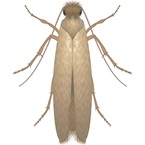Species category: Flying pest
Scientific Name: Culicidae
Description:
2 types of species:
- Culex pipiens (Common House Mosquito)
- Culex quinquefaciatus (Southern House Mosquito)
Average adult mosquitoes are 4-8mm in length; none exceeds 16mm. The head receives all sensory information and features the female’s biting proboscis. The wings can fly for long periods and their flapping creates a distinctive sound which often indicates their presence.
Behaviour:
Mosquitoes like warm weather but rest during the hottest part of the day. They are active from dusk until dawn.
Mosquitoes are attracted to food from great distances by:
- Light
- CO2
- Odour
They are weak flying insects and become inactive in windy conditions.
Only female mosquitoes bite, requiring blood to get nutrients for egg development. Males survive on nectar and other sugary substances. When females bite, they inject saliva with an anti-coagulant to prevent blood clotting and blocking their proboscis. Females store many-times their own weight of the host’s blood.
Region:
Typically natives of warm climates, House Mosquitoes are widespread in the Philippines.
Habitat:
Larval and pupal stages are aquatic. Breeding sites may be very small - transient pools of water close to houses or ponds and streams nearby. Mosquitoes are most commonly found outdoors, often close to the place they emerged.
They will travel long distances in search of food or the perfect egg-laying location. Females will then enter all rooms looking for blood and often strike victims when they rest.
Risks:
Mosquitoes can be a nuisance if the bites are harmless but for some can cause allergic reactions and lead to secondary infections when victims scratch the wounds.
Female mosquitoes act as vectors and can transmit life-threatening diseases like West Nile virus, filariasis (elephantitis), and encephalitis.







